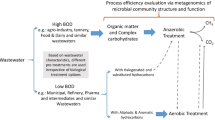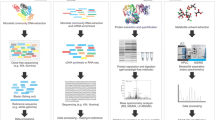Abstract
Activated sludge, a microbial ecosystem at industrial wastewater treatment plants, is an active collection of diverse gene pool that creates the intelligence required for coexistence at the cost of pollutants. This study has analyzed one such ecosystem from a site treating wastewater pooled from over 200 different industries. The metagenomics approach used could predict the degradative pathways of more than 30 dominating molecules commonly found in wastewater. Results were extended to design a bioremediation strategy using 4-methylphenol, 2-chlorobenzoate, and 4-chlorobenzoate as target compounds. Catabolic potential required to degrade four aromatic families, namely benzoate family, PAH family, phenol family, and PCB family, was mapped. Results demonstrated a network of diverse genera, where a few phylotypes were seen to contain diverse catabolic capacities and were seen to be present in multiple networks. The study highlights the importance of looking more closely at the microbial community of activated sludge to harness its latent potential. Conventionally treated as a black box, the activated biomass does not perform at its full potential. Metagenomics allows a clearer insight into the complex pathways operating at the site and the detailed documentation of genes allows the activated biomass to be used as a bioresource.






Similar content being viewed by others
References
Balcom IN, Driscoll H, Vincent J, Leduc M (2016) Metagenomic analysis of an ecological wastewater treatment plant’s microbial communities and their potential to metabolize pharmaceuticals. F1000Research:5
Chhatre S, Purohit HJ, Shanker R, Khanna P (1996) Bacterial consortia for crude oil spill remediation. Water Sci Technol 34:187–193
de Souza Pereira M, Kuch B (2005) Heavy metals, PCDD/F and PCB in sewage sludge samples from two wastewater treatment facilities in Rio de Janeiro State, Brazil. Chemosphere 60:844–853
Garrido-Sanz D, Manzano J, Martín M, Redondo-Nieto M, Rivilla R (2018) Metagenomic analysis of a biphenyl-degrading soil bacterial consortium reveals the metabolic roles of specific populations. Front Microbiol 9:232
Jadeja NB, More RP, Purohit HJ, Kapley A (2014) Metagenomic analysis of oxygenases from activated sludge. Bioresour Technol 165:250–256
Janssen DB, Scheper A, Dijkhuizen L, Witholt B (1985) Degradation of halogenated aliphatic compounds by Xanthobacter autotrophicus GJ10. Appl Environ Microbiol 49:673–677
Jia KZ, Cui ZL, He J, Guo P, Li SP (2006) Isolation and characterization of a denitrifying monocrotophos-degrading Paracoccus sp. M-1. FEMS Microbiol Lett 263:155–162
Jiao S, Chen W, Wang E, Wang J, Liu Z, Li Y, Wei G (2016) Microbial succession in response to pollutants in batch-enrichment culture. Sci Rep 6:21791
Jiménez DJ, de Lima Brossi MJ, Schückel J, Kračun SK, Willats WGT, van Elsas JD (2016) Characterization of three plant biomass-degrading microbial consortia by metagenomics-and metasecretomics-based approaches. Appl Microbiol Biotechnol:1–15
Jørgensen VR, Dueholm MS, Knutsson S, Nierychlo M, Kristensen JM, Petriglieri F, Dottorini G, Yashiro E, Karst SM, Albertsen M, Nielsen PH (2018) Global database of microbes in wastewater treatment systems. In17th International Symposium on Microbial Ecology.
Kanehisa M, Goto S (2000) KEGG: Kyoto encyclopedia of genes and genomes. Nucleic Acids Res 28:27–30
Kantor RS, Zyl AW, Hille RP, Thomas BC, Harrison ST, Banfield JF (2015) Bioreactor microbial ecosystems for thiocyanate and cyanide degradation unravelled with genome-resolved metagenomics. Environ Microbial 17:4929–4941
Kapley A, Purohit HJ (2009) Diagnosis of treatment efficiency in industrial wastewater treatment plants: a case study at a refinery ETP. Environ Sci Technol 43:3789–3795
Kirkegaard RH, McIlroy SJ, Kristensen JM, Nierychlo M, Karst SM, Dueholm MS, Albertsen M, Nielsen PH, (2017a) The impact of immigration on microbial community composition in full-scale anaerobic digesters. Scientific Reports 7 (1)
Kirkegaard RH, McIlroy SJ, Kristensen JM, Nierychlo M, Karst SM, Dueholm MS, Albertsen M, Nielsen PH (2017b) Identifying the abundant and active microorganisms common to full scale anaerobic digesters. Biorxiv 1:104620.
Kapley A, De Baere T, Purohit HJ (2007a) Eubacterial diversity of activated biomass from a common effluent treatment plant. Res Microbiol 158:494–500
Kapley A, Prasad S, Purohit HJ (2007b) Changes in microbial diversity in fed-batch reactor operation with wastewater containing nitroaromatic residues. Bioresour Technol 98:2479–2484
Kapley A, Tanksale H, Sagarkar S, Prasad AR, Kumar RA, Sharma N, Qureshi A, Purohit HJ (2016) Antimicrobial activity of Alcaligenes sp. HPC 1271 against multidrug resistant bacteria. Funct Integr Genomics 16:57–65
Land M, Hauser L, Jun SR, Nookaew I, Leuze MR, Ahn TH, Karpinets T, Lund O, Kora G, Wassenaar T, Poudel S (2015) Insights from 20 years of bacterial genome sequencing. Funct Integr Genomics 15:141–161
Leewis MC, Uhlik O, Leigh MB (2016) Synergistic processing of biphenyl and benzoate: carbon flow. Through the bacterial community in polychlorinated-biphenyl-contaminated soil. Sci Rep 6:22145
Lekunberri I, Balcázar JL, Borrego CM, (2018) Metagenomic exploration reveals a marked change in the river resistome and mobilome after treated wastewater discharges. Environmental Pollution 234:538–542
Lingner T, Aßhauer KP, Schreiber F, Meinicke P (2011) CoMet—a web server for comparative functional profiling of metagenomes. Nucleic Acids Res p.gkr388
Marti E, Jofre J, Balcazar JL, Elias D, (2013) Prevalence of Antibiotic Resistance Genes and Bacterial Community Composition in a River Influenced by a Wastewater Treatment Plant. PLoS ONE 8 (10):e78906
Martini MC, Wibberg D, Lozano M, Tejerizo GT, Albicoro FJ, Jaenicke S, Van Elsas JD, Petroni A, Garcillán-Barcia MP, De La Cruz F, Schlüter A (2016) Genomics of high molecular weight plasmids isolated from an on-farm biopurification system. Sci Rep 6:28284
Mason OU, Hazen TC, Borglin S, Chain PS, Dubinsky EA, Fortney JL, Han J, Holman HYN, Hultman J, Lamendella R, Mackelprang R (2012) Metagenome, metatranscriptome and single-cell sequencing reveal microbial response to Deepwater Horizon oil spill. ISME J 6:1715–1727
Meyer F, Paarmann D, D'Souza M, Olson R, Glass EM, Kubal M, Paczian T, Rodriguez A, Stevens R, Wilke A, Wilkening J (2008) The metagenomics RAST server–a public resource for the automatic phylogenetic and functional analysis of metagenomes. BMC Bioinformatics 9:386
Moharikar A, Kapley A, Purohit HJ (2003) Detection of dioxygenase genes present in various activated sludge. Environ Sci Pollut Res 10:373–378
More RP, Mitra S, Raju SC, Kapley A, Purohit HJ (2014) Mining and assessment of catabolic pathways in the metagenome of a common effluent treatment plant to induce the degradative capacity of biomass. Bioresour Technol 153:137–146
Nie Y, Tang YQ, Li Y, Chi CQ, Cai M, Wu XL (2012) The genome sequence of Polymorphum gilvum SL003B-26A1 T reveals its genetic basis for crude oil degradation and adaptation to the saline soil. PLoS One 7:1261
Nolvachai Y, Kulsing C, Marriott PJ (2015) Pesticides analysis: advantages of increased dimensionality in gas chromatography and mass spectrometry. Crit Re Environ Sci Technol 45:2135–2173
Okuda S, Yamada T, Hamajima M, Itoh M, Katayama T, Bork P, Goto S, Kanehisa M (2008) KEGG Atlas mapping for global analysis of metabolic pathways. Nucleic Acids Res 36:423–426
Pagé AP, Yergeau É, Greer CW (2015) Salix purpurea stimulates the expression of specific bacterial xenobiotic degradation genes in a soil contaminated with hydrocarbons. PLoS One 10:e0132062
Pal RR, Khardenavis AA, Purohit HJ (2015) Identification and monitoring of nitrification and denitrification genes in Klebsiella pneumoniae EGD-HP19-C for its ability to perform heterotrophic nitrification and aerobic denitrification. Funct Integr Genomics 15:63–76
Parks DH, Tyson GW, Hugenholtz P, Beiko RG (2014) STAMP: statistical analysis of taxonomic and functional profiles. Bioinformatics 30:3123–3124
Pérez-Pantoja D, Donoso R, Agulló L, Córdova M, Seeger M, Pieper DH, González B (2012) Genomic analysis of the potential for aromatic compounds biodegradation in Burkholderiales. Environ Microbiol 14:1091–1117
Rani A, Porwal S, Sharma R, Kapley A, Purohit HJ, Kalia VC (2008) Assessment of microbial diversity in effluent treatment plants by culture dependent and culture independent approaches. Bioresour Technol 99:7098–7107
Reunamo A, Yli-Hemminki P, Nuutinen J, Lehtoranta J, Jørgensen KS (2016) Degradation of crude oil and PAHs in iron–manganese concretions and sediment from the northern Baltic Sea. Geomicrobiol J (just-accepted)
Rosso GE, Muday JA, Curran JF (2018) Tools for Metagenomic Analysis at Wastewater Treatment Plants:Application to a Foaming Episode. Water Environment Research 90 (3):258–268
Rudrashetti AP, Jadeja NB, Gandhi D, Juwarkar AA, Sharma A, Kapley A, Pandey RA (2017) Microbial population shift caused by sulfamethoxazole in engineered-soil aquifer treatment (e-SAT) system. World J Microbiol Biotechnol 33:121
Sambrook J, Fritsch EF, Maniatis T (1989) Molecular cloning, vol 2. Cold spring harbor laboratory press, New York
Saunders AM, Albertsen M, Vollertsen J, Nielsen PH (2016) The activated sludge ecosystem contains a core community of abundant organisms. ISME J 10:11–20
Shah V, Zakrzewski M, Wibberg D, Eikmeyer F, Schlüter A, Madamwar D (2013) Taxonomic profiling and metagenome analysis of a microbial community from a habitat contaminated with industrial discharges. Microb Ecol 66:533–550
Simon C, Rolf D (2009) Achievements and new knowledge unraveled by metagenomic approaches. Appl Microbiol Biotechnol 85:265–276
Stokholm-Bjerregaard M, McIlroy SM, Nierychlo M, Karst SM, Albertsen M, Nielsen PH, (2017) A Critical Assessment of the Microorganisms Proposed to be Important to Enhanced Biological Phosphorus Removal in Full-Scale Wastewater Treatment Systems. Frontiers in Microbiology 8:718
Van den Tweel WJ, Kok JB, De Bont JA (1987) Reductive dechlorination of 2, 4-dichlorobenzoate to 4-chlorobenzoate and hydrolytic dehalogenation of 4-chloro-, 4-bromo-, and 4-iodobenzoate by Alcaligenes denitrificans NTB-1. Appl Environ Microbiol 53:810–815
Wang X, Hu M, Xia Y, Wen X, Ding K (2012) Pyrosequencing analysis of bacterial diversity in 14 wastewater treatment systems in China. Appl Environ Microbiol 78:7042–7047
Yadav TC, Khardenavis AA, Kapley A (2014) Shifts in microbial community in response to dissolved oxygen levels in activated sludge. Bioresour Technol 165:257–264
Yadav TC, Pal RR, Shastri S, Jadeja NB, Kapley A (2015) Comparative metagenomics demonstrating different degradative capacity of activated biomass treating hydrocarbon contaminated wastewater. Bioresour Technol 188:24–32
Zaki GR, El-Marakby FA, Ramadan AE, Issa AI, Nofal FH (2016) Control of occupational exposure to phenol in industrial wastewater treatment plant of a petroleum refinery in Alexandria, Egypt: an intervention application case study. J Occup Environ Hyg (just-accepted) 13:D208–D214
Web reference
Graph editor, used on 1st March 2016, website link: http://illuminations.nctm.org/Activity.aspx?id=3550
KEGG Pathway Skeleton based classification, used on 15th February, website link: http://www.genome.jp/kegg/pathway.html
Acknowledgements
The authors are grateful to the Council of Scientific and Industrial Research, India, CSIR-network project ESC-0108-MESER, for supporting this research. Niti B Jadeja is grateful to CSIR for the Senior Research Fellowship. The authors also acknowledge Ankleshwar CETP authorities for providing activated sludge and wastewater samples used in this study. The manuscript has been checked for plagiarism at an institute, reference no. KRC No.: KRC/2016/MAY/EGD/1.
Author information
Authors and Affiliations
Corresponding author
Ethics declarations
Conflict of interest
All authors declare that they have no competing interests.
Ethical approval
No ethical approval is required since this study did not involve animals/human samples.
Additional information
Publisher’s note
Springer Nature remains neutral with regard to jurisdictional claims in published maps and institutional affiliations.
Electronic supplementary material
ESM 1
(DOCX 2675 kb)
Rights and permissions
About this article
Cite this article
Jadeja, N.B., Purohit, H.J. & Kapley, A. Decoding microbial community intelligence through metagenomics for efficient wastewater treatment. Funct Integr Genomics 19, 839–851 (2019). https://doi.org/10.1007/s10142-019-00681-4
Received:
Revised:
Accepted:
Published:
Issue Date:
DOI: https://doi.org/10.1007/s10142-019-00681-4




